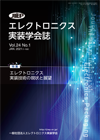Volume 24, Issue 1
Displaying 1-36 of 36 articles from this issue
- |<
- <
- 1
- >
- >|
Preface
-
Article type: Preface
2021Volume 24Issue 1 Pages P1
Published: January 01, 2021
Released on J-STAGE: January 01, 2021
Download PDF (219K)
Special Articles / Electronics Packaging Technology: The Current Status and Perspective
-
Article type: Special Articles
2021Volume 24Issue 1 Pages 1
Published: January 01, 2021
Released on J-STAGE: January 01, 2021
Download PDF (254K) -
Article type: Special Articles
2021Volume 24Issue 1 Pages 2-7
Published: January 01, 2021
Released on J-STAGE: January 01, 2021
Download PDF (684K) -
Article type: Special Articles
2021Volume 24Issue 1 Pages 8-11
Published: January 01, 2021
Released on J-STAGE: January 01, 2021
Download PDF (732K) -
Article type: Special Articles
2021Volume 24Issue 1 Pages 12-14
Published: January 01, 2021
Released on J-STAGE: January 01, 2021
Download PDF (506K) -
Article type: Special Articles
2021Volume 24Issue 1 Pages 15-24
Published: January 01, 2021
Released on J-STAGE: January 01, 2021
Download PDF (1615K) -
Article type: Special Articles
2021Volume 24Issue 1 Pages 25-29
Published: January 01, 2021
Released on J-STAGE: January 01, 2021
Download PDF (808K) -
Article type: Special Articles
2021Volume 24Issue 1 Pages 29-33
Published: January 01, 2021
Released on J-STAGE: January 01, 2021
Download PDF (1320K) -
Article type: Special Articles
2021Volume 24Issue 1 Pages 34-37
Published: January 01, 2021
Released on J-STAGE: January 01, 2021
Download PDF (934K) -
Article type: Special Articles
2021Volume 24Issue 1 Pages 38-42
Published: January 01, 2021
Released on J-STAGE: January 01, 2021
Download PDF (853K) -
Article type: Special Articles
2021Volume 24Issue 1 Pages 43-48
Published: January 01, 2021
Released on J-STAGE: January 01, 2021
Download PDF (650K) -
Article type: Special Articles
2021Volume 24Issue 1 Pages 49-55
Published: January 01, 2021
Released on J-STAGE: January 01, 2021
Download PDF (1213K) -
Article type: Special Articles
2021Volume 24Issue 1 Pages 56-62
Published: January 01, 2021
Released on J-STAGE: January 01, 2021
Download PDF (1710K) -
Article type: Special Articles
2021Volume 24Issue 1 Pages 63-66
Published: January 01, 2021
Released on J-STAGE: January 01, 2021
Download PDF (538K) -
Article type: Special Articles
2021Volume 24Issue 1 Pages 67-70
Published: January 01, 2021
Released on J-STAGE: January 01, 2021
Download PDF (671K) -
Article type: Special Articles
2021Volume 24Issue 1 Pages 71-76
Published: January 01, 2021
Released on J-STAGE: January 01, 2021
Download PDF (828K) -
Article type: Special Articles
2021Volume 24Issue 1 Pages 77-81
Published: January 01, 2021
Released on J-STAGE: January 01, 2021
Download PDF (606K) -
Article type: Special Articles
2021Volume 24Issue 1 Pages 82-88
Published: January 01, 2021
Released on J-STAGE: January 01, 2021
Download PDF (1323K) -
Article type: Special Articles
2021Volume 24Issue 1 Pages 89-95
Published: January 01, 2021
Released on J-STAGE: January 01, 2021
Download PDF (1163K) -
Article type: Special Articles
2021Volume 24Issue 1 Pages 96-98
Published: January 01, 2021
Released on J-STAGE: January 01, 2021
Download PDF (510K) -
Article type: Special Articles
2021Volume 24Issue 1 Pages 99-100
Published: January 01, 2021
Released on J-STAGE: January 01, 2021
Download PDF (507K)
Technical Paper
-
Article type: Technical Paper
2021Volume 24Issue 1 Pages 101-106
Published: January 01, 2021
Released on J-STAGE: January 01, 2021
Advance online publication: October 28, 2020Download PDF (1608K) -
Article type: Technical Paper
2021Volume 24Issue 1 Pages 107-114
Published: January 01, 2021
Released on J-STAGE: January 01, 2021
Advance online publication: November 06, 2020Download PDF (1864K) -
Article type: Technical Paper
2021Volume 24Issue 1 Pages 115-120
Published: January 01, 2021
Released on J-STAGE: January 01, 2021
Advance online publication: October 29, 2020Download PDF (1010K) -
Article type: Technical Paper
2021Volume 24Issue 1 Pages 121-129
Published: January 01, 2021
Released on J-STAGE: January 01, 2021
Advance online publication: October 29, 2020Download PDF (1610K) -
Article type: Technical Paper
2021Volume 24Issue 1 Pages 130-142
Published: January 01, 2021
Released on J-STAGE: January 01, 2021
Advance online publication: November 11, 2020Download PDF (2258K) -
Article type: Special Articles
2021Volume 24Issue 1 Pages 143-147
Published: January 01, 2021
Released on J-STAGE: January 01, 2021
Advance online publication: December 09, 2020Download PDF (1225K) -
Article type: Technical Paper
2021Volume 24Issue 1 Pages 148-153
Published: January 01, 2021
Released on J-STAGE: January 01, 2021
Advance online publication: December 09, 2020Download PDF (838K)
Tutorial Series-Boundary-Scan Technology Course / (9)
-
Article type: Tutorial Series
2021Volume 24Issue 1 Pages 154-161
Published: January 01, 2021
Released on J-STAGE: January 01, 2021
Download PDF (1460K)
Report
-
Article type: Report
2021Volume 24Issue 1 Pages 162
Published: January 01, 2021
Released on J-STAGE: January 01, 2021
Download PDF (445K)
Announcement, Contents, etc.
-
Article type: Special Articles
2021Volume 24Issue 1 Pages 163
Published: January 01, 2021
Released on J-STAGE: January 01, 2021
Download PDF (236K) -
Article type: Announcement
2021Volume 24Issue 1 Pages 165-166
Published: January 01, 2021
Released on J-STAGE: January 01, 2021
Download PDF (386K) -
Article type: Announcement
2021Volume 24Issue 1 Pages A11-
Published: January 01, 2021
Released on J-STAGE: January 01, 2021
Download PDF (331K) -
Article type: Announcement
2021Volume 24Issue 1 Pages C11
Published: January 01, 2021
Released on J-STAGE: January 01, 2021
Download PDF (245K) -
Article type: Announcement
2021Volume 24Issue 1 Pages C12
Published: January 01, 2021
Released on J-STAGE: January 01, 2021
Download PDF (193K) -
Article type: Announcement
2021Volume 24Issue 1 Pages I11-
Published: January 01, 2021
Released on J-STAGE: January 01, 2021
Download PDF (511K)
- |<
- <
- 1
- >
- >|
